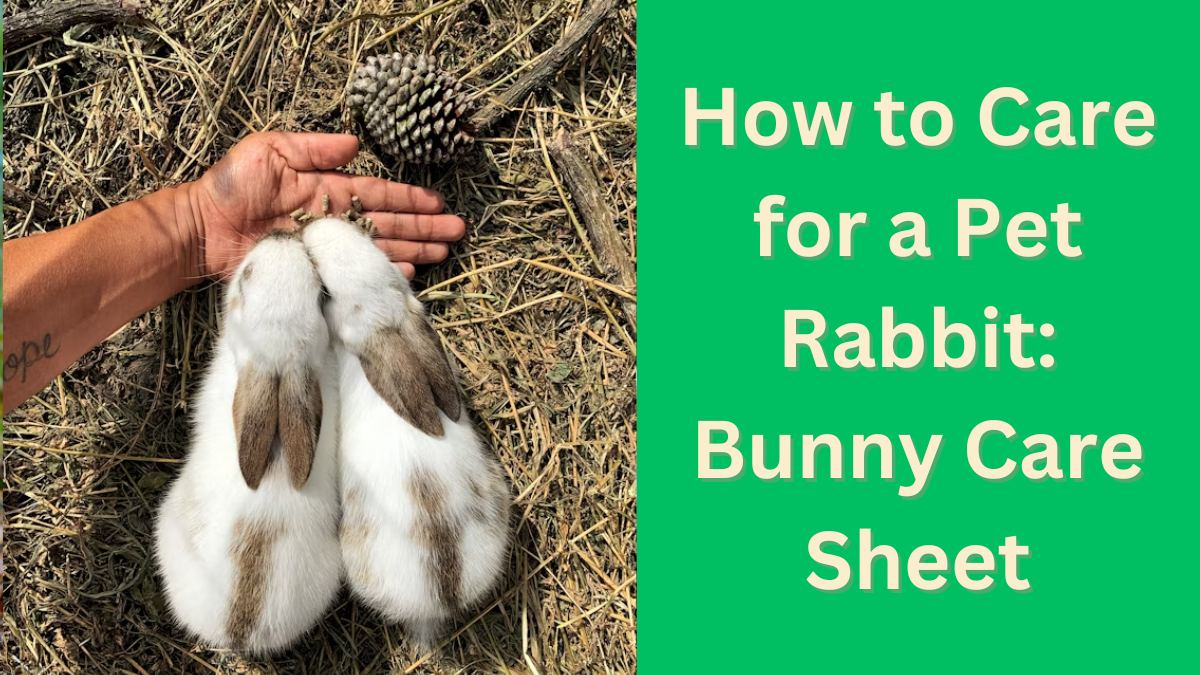Though they make amazing companions, rabbits need particular care to remain happy and healthy. Though many believe rabbits are low-maintenance animals, in fact they require appropriate housing, a balanced diet, social interaction, and frequent veterinarian treatment. Covering all you need to know about caring for a pet rabbit, this bunny care leaflet guarantees their long and happy life.
1. Selecting the Appropriate Pet Rabbit
Think on these before taking a Pet Rabbit home:
- Breed & Size: Small Netherland Dwarfs to massive Flemish Giants, rabbits come in a variety of varieties and sizes. Some breeds call for more room and attention than others.
- Personality: Whereas some rabbits are shy, others are lively and sociable. Spend time with a Pet Rabbit to be sure you fit well.
- Adoption vs. Purchasing: Think about adopting from a rescue or shelter rather than a pet store. Many rabbits housed in shelters yearn for loving homes.
2. Enclosure and Homes
The house of a Pet Rabbit ought to be cozy, large, and safe.
Indoor Living
- Either a big Pet Rabbit cage or an exercise pen (at least 4×4 feet for young rabbits and more for bigger types).
- Avoid wire flooring; a solid-bottom cage will protect their feet.
- Avoid pine and cedar shavings; soft bedding is either fleece or paper-based.
- A hiding place—perhaps a cardboard box or a wooden hideaway.
- Litter box filled with rabbit-safe non-clumping cat litter.
Outside Real Estate
- Rising above the ground, a waterproof hutch.
- A safe run for fitness.
- Defense against predators, severe temperatures, and bright sunlight.
For rabbits, though, indoor living is safer and more social since they can interact with their owners and are shielded from outside hazards.
3. Food and Nutritional Values
The nutrition of a Pet Rabbit determines its condition greatly. Their sensitive digestive systems mean that correct eating is absolutely vital.
What should you feed your rabbit?
- Hay (80% of the diet): Always be readily accessible fresh timothy hay, sometimes known as orchard grass for variation. For dental health and digestion, it is absolutely vital.
- Five to ten percent of the food are pellets: High-fiber Pet Rabbit pellets should be avoided those containing seeds or dried fruit. Feed five pounds of body weight around ¼ cup daily.
- Fresh Vegetables (10–15% of the diet): Romaine lettuce, cilantro, parsley, and dandelion greens among dark leafy greens. Start adding fresh vegetables little by bit.
- Restricted Fruits: Little amounts of berries, banana, apple (without seeds).
NOT Things You Should Feed Your Rabbit
- Low in nutrition, iceberg lettuce can aggravate stomach problems.
- There are no processed or sweet foods—cookies, crackers, cereal.
- No avocado, chocolate, garlic, or onions—all of which are poisonous to rabbits.
4. Hygiene and Grooming
Though they are inherently tidy animals, rabbits nevertheless require some grooming and attention.
- Brushing one to two times a week (daily for long-haired breeds like Angoras) helps avoid hairballs as rabbits shed constantly.
- Cut nails every four to six weeks to stop overgrowth.
- Look for evidence of mites, wax buildup, or infection in the ears.
- Give chew toys and hay to help to wear down teeth. Rabbit teeth keep growing never stopping!
5. Exercise & Socialization
Social and intelligent animals, rabbits require regular playfulness and connection.
Social Interests
- Rabbits like company; think about keeping a bonded pair.
- Spend everyday time petting, talking, and playing with your lonely rabbit.
- Though they appreciate sitting next to their owners for caressing, rabbits do not always prefer being picked up.
Playfulness and Exercise
- Give your rabbit at least three to four hours every day to roam in a safe, bunny-proofed space.
- To keep them occupied, offer toys—cardboard boxes, tunnels, hay balls.
- Offering safe chew toys and digging boxes, rabbits enjoy digging and chewing.
6. Training in Littering
Just as with cats, rabbits can be litter trained!
Litter Training Your Rabbit: How To
- Choose a litter box with rabbit-safe litter; steer clear of perfumed or clumped litter.
- Set it in their exercise and cage area.
- Hay would be great for the box since rabbits enjoy eating from the litter box.
- Reward exemplary behavior with little compliments or treats.
Conclusion
Although taking care of a pet rabbit is fulfilling, it also calls dedication. You will guarantee your bunny’s long, healthy, and happy existence by offering a suitable nutrition, home, socializing, and medical treatment. Love and attention make bunnies devoted and loving friends!
FAQs
My pet rabbit should eat what?
Eighty percent fresh hay, ten to fifteen percent leafy greens, and a tiny portion of pellets should make up a rabbit’s food. Fruit among other treats should be consumed in moderation.
Can I leave my rabbit in a cage all day?
To remain healthy and happy, rabbits must at least spend three to four hours each day outside their cage in a bunny-proofed area.
How should I instruct my bunny in littering?
Put a litter box with rabbit-safe litter in their play area and enclosure. Load the box with hay, then praise them for using it appropriately.
